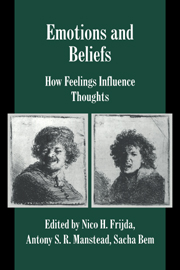Book contents
- Frontmatter
- Contents
- Contributors
- 1 The influence of emotions on beliefs
- 2 Feeling is believing: Some affective influences on belief
- 3 Beliefs through emotions
- 4 The sentiments and beliefs of distributed cognition
- 5 Feeling is believing? The role of processing strategies in mediating affective influences on beliefs
- 6 The formation of beliefs at the interface of affective and cognitive processes
- 7 Anxiety, cognitive biases, and beliefs
- 8 A cognitive dissonance theory perspective on the role of emotion in the maintenance and change of beliefs and attitudes
- 9 Relationship beliefs and emotion: Reciprocal effects
- Index of authors
- Index of subjects
- Studies in Emotion and Social Interaction
2 - Feeling is believing: Some affective influences on belief
Published online by Cambridge University Press: 10 March 2010
- Frontmatter
- Contents
- Contributors
- 1 The influence of emotions on beliefs
- 2 Feeling is believing: Some affective influences on belief
- 3 Beliefs through emotions
- 4 The sentiments and beliefs of distributed cognition
- 5 Feeling is believing? The role of processing strategies in mediating affective influences on beliefs
- 6 The formation of beliefs at the interface of affective and cognitive processes
- 7 Anxiety, cognitive biases, and beliefs
- 8 A cognitive dissonance theory perspective on the role of emotion in the maintenance and change of beliefs and attitudes
- 9 Relationship beliefs and emotion: Reciprocal effects
- Index of authors
- Index of subjects
- Studies in Emotion and Social Interaction
Summary
“Winter Light” is the name of a film by the Swedish film-maker Ingmar Bergman. In it he depicts life in a remote Swedish village in the depths of winter. One of the unhappy characters in this village becomes obsessed with the “Red Chinese” and the inevitability of nuclear war. Throughout the film, the sun barely shines over the horizon, the snowy landscape is barren, and the interpersonal climate is equally cold. There are plenty of reasons for depression very close to home, but this character believes that he is depressed about something thousands of miles away. And in the end, he kills himself, and he does so, he says, because of the “Red Chinese.”
Two important attributes of emotional feelings are that they provide information and guide attention. These attributes appear to be generally functional, but they can also go awry. When they do, they produce very different, indeed opposite, effects. The suicide of Bergman's character illustrates both. First, when affective states lack salient objects; the information they provide may be misattributed to substitute objects, and second, when affective states do have salient objects, they may lead one to an overly narrow focus of attention.
In this chapter we discuss the ways in which moods and emotions might influence beliefs. The first half of the chapter discusses seven basic principles underlying our research on general mood, and the second half builds on these principles focusing on how specific emotions may affect beliefs. There is insufficient research on emotions and belief to derive well-supported principles.
- Type
- Chapter
- Information
- Emotions and BeliefsHow Feelings Influence Thoughts, pp. 10 - 44Publisher: Cambridge University PressPrint publication year: 2000
- 26
- Cited by



